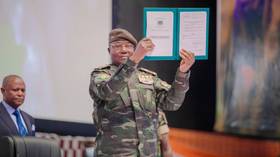‘No plan for after the invasion’: How an effort at rebuilding destroyed Iraq
Ten years since the start of the war in Iraq, many are questioning whether US efforts not only did little to alleviate suffering, but created the kind of stalemate that has set Iraq on course for an even greater catastrophe.
At least 134,000 Iraqi civilians are estimated to have died in
the conflict, according to the Costs of War Project by the Watson
Institute for International Studies at Brown University, published
on Sunday. And the overall number of casualties could be four times
higher, researchers say.
Assistant Editor at Antiwar. Com, John Glaser, told RT of the
broken promises made to the US public back home and to the people
of Iraq. “What we can know for sure is the constant lies told by
the Bush administration that the war would be over in a couple of
months, it would be paid for with Iraqi oil, we would be greeted as
liberators, there would not be the sort of civil war that
eventually descended onto Iraq…they were all wrong, all of these
predictions were wrong. And yet, these same types of
neo-conservatives can go on television and on book tours and sit in
their fancy homes and not feel embarrassed about how wrong they
were. Iraq is in chaos right now, flooded with sectarian
tension and a dictatorship that the United States helped
install.”
That is not to say that everyone thinks that removing Saddam
Hussein’s dictatorial rule was a mistake. But the end of his
tyranny brought about a democracy which was plagued by corruption
and in-fighting, often among warring tribes, heavily armed. Since
America’s withdrawal some of the failings of the operation have
only been heightened, with deadly terrorist attacks continuing
around the country; testament to this, a series of 10 blasts that
shook the capital Baghdad, claiming nearly 60 lives and wounding
over 200 people, right on the eve of the 10th anniversary of the US
invasion of Iraq. The attacks bore a strong Al Qaeda signature,
targeting mainly Shiite areas around the capital.
Michael O’Brien, who has authored a book entitled ‘America’s
Failure in Iraq’, explained to RT the reason behind the surge in
violence. “Not only was there no plan for after the invasion,
but then Paul Brenner disbanded Iraq’s own security ministries: the
Iraqi military and the Iraqi National Police, which is like an
interior army. So, with no plan for after the invasion for
the US and Coalition forces…and the fact that Bremer disbanded
Iraq’s own infrastructure for security, it is not at all
coincidental that insurgency picked up around 2005-2006. So we are
very much responsible for creating the insurgency that followed a
war that was dubious in the first place.” Paul Bremer was the
Administrator of the Coalition Provisional Authority of Iraq,
following the invasion in 2003.
The sums spent on the invasion and subsequent occupation of Iraq,
are astronomical and still growing. Aid to Iraq itself leaves much
to question, with billions of dollars spent on security and
projects often failing to come to fruition. When questioned about
the efficacy of US military spending in the conflict, Glaser said
“the [figure] is truly immense, it’s too immense to grasp. The
final cost of the war could be approaching somewhere about $ 6
trillion, according to a recent study by Brown university. That’s a
number that nobody can really fathom. And we’re going to be paying
for it for a long, long time.”
$212 billion was supposed to be spent on aid to the Iraqis
themselves, but today their lives aren’t much better than during
the sanctions imposed on them in 1990 by the UN, when Iraq invaded
Kuwait. Less than 40 percent of adults have a job, while a quarter
of the country lives below the World Bank’s poverty line. Speaking
of where the rebuilding funds went and whether they are doing any
good, Director of the Institute of Public Accuracy, Norman
Sullivan, said that only the ruling elite benefit: “It’s doing
an elite good. Al Maliki and others who are running the government,
they’re skimming off huge profit. But on the whole, there’s very
little trickling down to the average Iraqi person.”
As to why the US left after failing to stabilize Iraq and losing
treasure and lives in the process, those in the know have pointed
to the lack of options left on the table. When questioned about the
justification of the US effort there, Sullivan quoted Daniel
Ellsberg, the Pentagon Papers whistleblower as saying “complete
US withdrawal of military troops in Iraq is a terrible option. And
all the other options are worse.”
And the Middle East doesn’t appear to be quieting down after US
withdrawal from Iraq and its protracted confrontation with
extremists in Afghanistan, as well as the threat of other countries
destroying each other in the region. John Glaser does not feel the
US has learned any lessons in the 10 years since the start of the
Iraq war. “It can be argued that the Obama administration is
weary of getting involved in another military quagmire in the
Middle East, because of what happened in Iraq. So, instead they
focus on making the entire globe a war zone, so they can drone
anywhere they want. So, there are new complications and new
problems. But the fundamental lesson – about how wrong American
Empire is – has not been learned. “
The statements, views and opinions expressed in this column are solely those of the author and do not necessarily represent those of RT.













